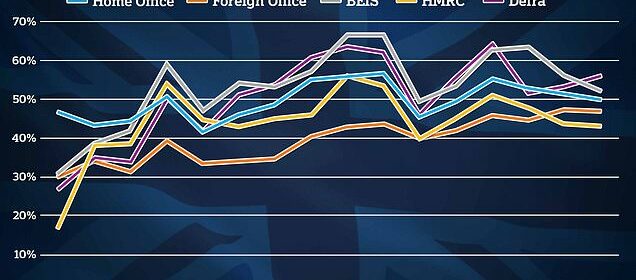Government office attendance figures revealed as staff continue to WFH

How as little as 29% of Government staff are in the office: Civil servants still work from home 18 months after Covid guidance was dropped as campaigners call on departments to ‘sell off unused space’
- Attendance drops as low as 29% at Defra in w/c May 29; while Home Office is 31%
- Average monthly occupancy at about 50% for both as well as other departments
Whitehall office buildings are still less than a third full as civil servants continue to work from home nearly 18 months after the Government dropped the requirement.
Just 29 per cent of staff at the Department for Environment, Food and Rural Affairs (Defra) turned up at its Marsham Street offices in Westminster in the last week of May.
And the figures were barely better at the London headquarters of the Home Office (31 per cent), Department for Business, Energy and Industrial Strategy (32 per cent), HM Revenue and Customs (also 32 per cent) and Foreign Office (34 per cent).
The departmental data for the week commencing May 29 must be put in the context of it being the half-term holidays for schools and the House of Commons.
But average occupancy for these five departments over the whole of last month was still only at around 50 per cent for them all – ranging between 43 and 56 per cent.
The findings were met with fury by the TaxPayers’ Alliance, whose spokesman Conor Holohan said: ‘Taxpayers resent paying for empty desks. Hard-pressed households continue to pay for vast swathes of empty offices on the Government estate. The Government should sell off unused space or get workers back behind their desks.’
Research by MailOnline examined data collected by departments and provided to the Cabinet Office since February 2022, which shows the percentage of staff in the office of current daily capacity.
ANDREW PIERCE: Is a planned rail overhaul stuck in sidings due to civil servants working from home?
The data started being collected after Boris Johnson announced on January 19, 2022 that the Government was no longer asking people to work from home, with all other ‘Plan B’ measures in England lifted eight days later.
At that point, civil servants who had been following government guidance and working from home could then start returning to their workplaces.
The data shows a general picture for these five departments that occupancy rose throughout 2022 before stabilising at around 50 per cent this year.
The Foreign Office started in February 2022 with 30 per cent, but was at 47 per cent last month; the Department for Business has gone from 31 per cent to 52 per cent; and Defra started at 27 per cent but is now at 56 per cent.
The Home Office has only risen slightly over the period, from 47 per cent to 50 per cent.
HMRC has seen the biggest change, having started off as low as 17 per cent in February 2022, with only 11 per cent for the week commencing February 14.
The figure rose to 56 per cent by October 2022 – but has since fallen to 43 per cent last month.
The highest attendance figure for a single week across the five departments since February 2022 was recorded at Defra, which had 77 per cent occupancy in the week commencing September 5 last year.
Last year, Jacob Rees-Mogg mounted an offensive against civil servants refusing to come back into the office during his stint at Government Efficiency Minister.
READ MORE Google will now make in-office work attendance a part of workers’ performance reviews
He was leaving notes on empty desks in the Cabinet Office saying: ‘Sorry you were out. I look forward to seeing you in the office very soon.’
But his efforts appear to have fallen by the wayside under Prime Minister Rishi Sunak’s regime.
In April, it was revealed that government office designs now assume just 50 per cent of staff will be in at any one time.
The assumed attendance has been reduced from 66 per cent in the wake of Covid – suggesting up to half will be working from home in the future.
As the Daily Mail’s Andrew Pierce reported today, figures released last week show that the Department for Transport has spent £121,000 in the past year on IT equipment and office furniture for staff working from home.
The report added that Transport Minister Jesse Norman could not provide a breakdown on the specific categories of equipment, and that other departments do not keep centralised figures on working from home equipment.
On May 17, Jeremy Hunt warned that working from home can hit ‘creativity’ as he insisted going into the office should be the ‘default’ option.
The Chancellor acknowledged video conferencing and other remote tools offer some ‘exciting opportunities’ including being able to ‘stay in touch’ with work while looking after a baby.
The Home Office saw around half of staff working from home last month. Jacob Rees-Mogg took this picture in the Cabinet Office to highlight the issue of WFH civil servants last year
But he said he ‘worried’ that firms were losing out through staff not being able to ‘bounce ideas off each other’ – suggesting people should be in the office unless there was a ‘good reason’.
READ MORE Intercity train operators see a post-pandemic boost with more journeys this year than in 2019 – while commuter belt lines struggle with some on just 62% of pre-Covid levels
Last month, Michael Gove’s Department for Levelling Up, Homes and Community signed a £200,000 contract to provide desks and chairs for its WFH civil servants.
The Government contract was described as providing for ‘the purchase of home working equipment to be used by the Department for Levelling Up, Housing and Communities (DLUHC) employees at their home locations’.
The DLUHC plans to provide around 32 deliveries a month to the addresses of civil servants who are likely to have been recently recruited.
Data from the Office for National Statistics realised in February found that 16 per cent of working adults reported working from home only and 28 per cent reported both working from home and travelling to work over the period of September 2022 to January 2023.
It said workers in the highest income band, those educated to degree level or above, and those in professional occupations were most likely to report home only or hybrid working.
The Cabinet Office states in its notes on Government attendance figures that the four main collection methods are wifi and/or computer log-ins associated with location; swipe pass entry data; space or desk booking system; and manual count.
This data also does not count employees working in other locations such as other government buildings, other workplaces or working from home.
Jacob Rees-Mogg has also been leading the charge, having left notes on empty desks in the Cabinet Office saying: ‘Sorry you were out. I look forward to seeing you in the office very soon’
However, the Cabinet Office also states that work is underway to develop a common methodology for efficiently monitoring occupancy that provides a daily and historic trend record of office occupancy levels for a building.
The data is collected weekly and reported for the time period of Monday to Friday.
Sources within the Government told MailOnline that data published on desk occupancy is related to departmental headquarters only and insisted that inferences about the wider workforce should not be made based upon them.
On the Department for Energy Security and Net Zero – formerly part of the Department for Business, Energy and Industrial Strategy (BEIS) which was split in February – everyone’s contract of employment states their place of work that they are contractually obliged to attend.
For most staff, their stated workplace is an office location – but the department’s hybrid working policy applies to all employees.
For a small number of staff with health or other circumstances such as disabilities, the department has an individual risk assessment process to manage exemptions.
And on Defra, MailOnline understands the statistics reflect occupancy for Defra’s Marsham Street building only, which houses only 5 per cent of Defra’s total staff.
A Government spokesman told MailOnline today: ‘There is agreement across government on there being clear benefits from face-to-face, collaborative working and departments remain committed to having staff working in offices at pre-pandemic levels.’
Source: Read Full Article





